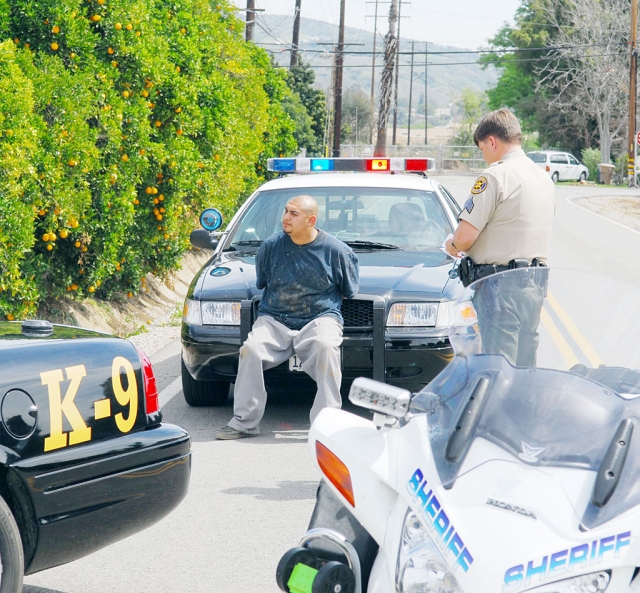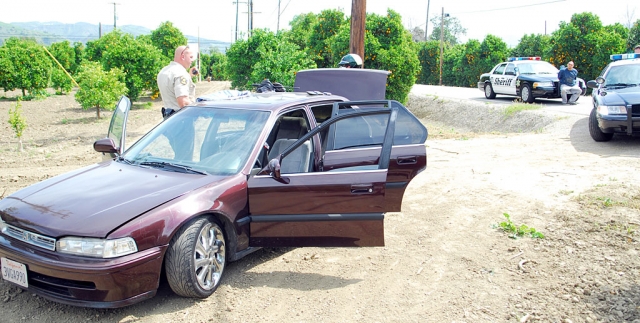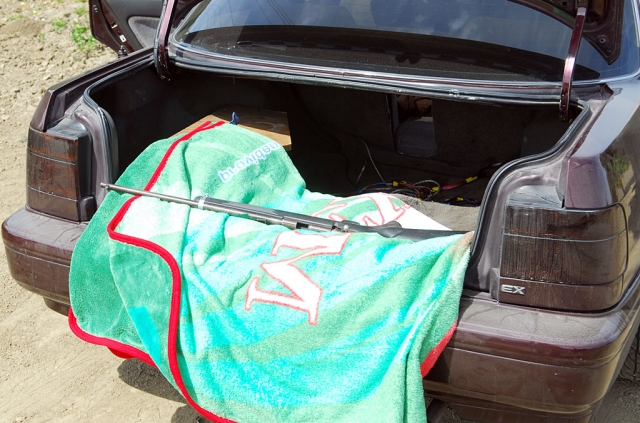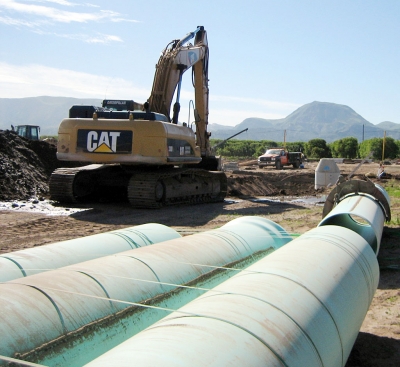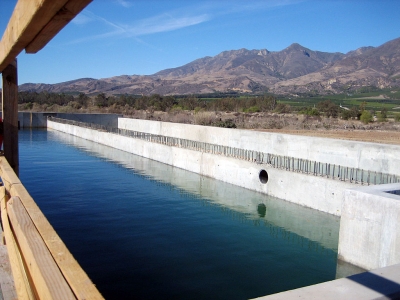|
By Anonymous — Wednesday, March 25th, 2009
Taggers caught in Piru
Location: Fillmore Police Station, Fillmore Suspects, City of Residence, Age, Fillmore and Piru residents have recently suffered damage to their property as a result of youth gang and graffiti tagging “Krews” who target public and private property. As a result, Detective Gene Torres is a deputy on a mission. Gene has become our expert in graffiti investigations. On Friday, March 20, 2009, Gene arrested 3 juvenile “tagging” suspects who are Krew leaders and responsible for thousands of dollars of damage. The three “taggers” were responsible for damaging the Piru Post Office and other private property, over and over again in the Fillmore area. All three juveniles were caught with graffiti tools and evidence. They were released to their parents pending court trials. When prosecuted, they will be required to provide financial restitution to the victims and typically commit to 30- 50 hours of community service. All three were arrested for 182(a)(1) PC / conspiracy, 594(b)(2)(A) PC / Vandalism, and 594.2(a) PC possession of graffiti tools. Individuals involved in the commission of these graffiti crimes continue to plague our community. We need your help in reporting acts of vandalism and if you have any information related to graffiti crime, please call the Senior Deputy Detective Taurino Almazan at 805-524-2233. |
|
By Anonymous — Tuesday, March 24th, 2009
Two arrested in Piru attempted murder
Locations: 1. 400 Block Collins Street, El Rio Date & Time: 3-19-2009 to 3-20-2009 (S)uspects, Charge, City of residence, Age 1. Luis Valenzuela, Oxnard, 20 2. Eddie Velasquez, El Rio, 38 |
|
By Anonymous — Monday, March 23rd, 2009
Suspect is Considered Armed and Dangerous
Felony Gang Weapons Arrest Case: 090006941 Suspects, Address, Age: On 03/19/2009, at about 1:30 p.m., Ventura County Sheriff’s K-9 Deputy, Scott Duffner, took two Fillmore-area gang members into custody for felony possession of a firearm in a vehicle and possession of a dangerous weapon (police baton). A third suspect, gang member /fugitive Alfredo Martinez, fled the area of the traffic stop and escaped arrest. Martinez is considered to be dangerous and he is a wanted fugitive by the Federal Government for weapons charges. Deputy Duffner attempted to stop the suspects’ Honda four-door sedan for traffic violations when the vehicle failed to yield on Telegraph Road in the City of Fillmore. The suspects continued to drive westbound out of the city and into the unincorporated rural area near Muir Street and Grand Avenue. Deputy Duffner suspected the suspects were organizing an attempt to escape. Suddenly, while Deputy Duffner was still attempting to stop the vehicle, the rear passenger door opened. Alfredo Martinez-Torres leapt from the vehicle while it was still in motion and fled into a nearby orchard. Moments later, the 17 year-old female gang member then jumped out of the car and tried to run. Despite being outnumbered, Deputy Duffner took her into custody without incident and he was also able to control the vehicle’s driver, Juan Ruiz. Almost immediately, Deputy Duffner located a rifle, ammunition, and police baton hidden in the vehicle. Additional deputies, including another K-9 unit and two helicopters, responded to the area and conducted an extensive two-hour search of the local orchards and the Sespe River area. Martinez-Torres was able to elude deputies, however, efforts continue to locate him and take him into custody. This was the fifth illegal gun seized from gang members in less than a week by Fillmore deputies. The Fillmore Police Department maintains a zero tolerance posture toward gangrelated crime and will continue to pursue and arrest gang members for all violations. The Ventura County Sheriff’s Department and the Fillmore Police Department encourage all citizens to immediately report suspicious and criminal activity and support the effort to make the community free from crime. Please call 9-1-1 if you see Alfredo Martinez-Torres (see attached photo) or know of his whereabouts. Ventura County Crime Stoppers will pay up to $1,000 reward for information, which leads to the arrest and criminal complaint against the person(s) responsible for this crime. The caller may remain anonymous. The call is not recorded. Call Crime Stoppers at (805) 524-0970. |
|
By Ventura County Sheriff Department — Friday, March 20th, 2009
Location: 323 A Street, Fillmore Victim, City of Residence, Age: Fillmore resident Ramon Izarraraz reported that he was the victim of a carjacking on Friday, March 20, 2009. Just after midnight, Izarraraz was sitting alone in his car in front of the Taco Llama restaurant at 323 A Street in Fillmore. As he was preparing to drive off, two male adult suspects approached on foot and began smashing out one of the windows of Izarraraz’s tan colored 1996 Toyota Camry, California license 4WZT410. The male suspects then forced their way into the car and assaulted Izarraraz. During the attack, the two suspects forcibly pulled Izarraraz from the car, and they drove off in his vehicle eastbound on Old Telegraph Road in Fillmore. Deputies searched Fillmore and the outlying communities for the vehicle but were unsuccessful in locating it. Detectives are actively working towards identifying the suspects. Any tips from the public concerning the identity of the suspects and/or the whereabouts of the victim’s vehicle would be greatly appreciated and held in confidence. The individuals involved in the commission of this crime are considered dangerous and should not be approached. If you have any information related to this crime, please call the Sheriff’s Department at 805-654-9511 or Detective Taurino Almazan at 805-524-2233. In case of emergency, always dial 9-1-1. |
 Accoring to police reports, at approximately 1:00 p.m. Thursday March 19, a passenger vehicle was pulled over on Grand Avenue. Before the vehicle came to a stop, a male individual ran from the passenger side and into a nearby orchard. The male driver and a 17 year old female passenger remained in the vehicle. Police began a foot pursuit. A helicopter was quick on scene to assist. The driver was found to have a baton next to him and the female passenger had access to the truck area of the vehicle which contained a hidden bolt action rifle. Both were arrested. The individual that fled is believed to have a federal warrant. More details will be posted as they become available. Enlarge Photo By Anonymous — Thursday, March 19th, 2009
Helicopter used to search for suspect
|
|
By Anonymous — Wednesday, March 18th, 2009
 Above, one of the weapons confiscated by Ventura County Sheriff’s deputies in the Saturday, March 14 surprise search of numerous gang locations. Sheriff’s Patrol, Gang, and Special Enforcement Units participated. Enlarge Photo 24 deputies from the Ventura County Sheriff’s Department Patrol, Gang and Special Enforcement Units conducted searches of known gang locations throughout the Fillmore area. A 17 year-old male gang member from River Street in Fillmore was arrested with a loaded 9mm semi automatic weapon. He was also arrested for street terrorism. During the searches, deputies also arrested gang member Jose Ruiz, 21, on Santa Clara Street in Fillmore for possession of a loaded .25 caliber semi-auto handgun. He, too, was arrested for street terrorism. Also arrested: Antonio Izarraraz, Felony Possession Stolen Property, Fillmore, 21 year old male, Rosa Aguliar, Under the Influence of Narcotics, Fillmore, 21 year old female, Armando Magallon, Under the Influence of Narcotics, Fillmore, 29 year old male, Jamie Ambriz, Under the Influence of Narcotics, Fillmore, 26 year old male, Male Juvenile, Gang Probation Violation, Fillmore, 17 year old, Jose Aguilar, Gang Probation Violation, Fillmore, 21 year old male, Male Juvenile, Gang Probation Violation, Fillmore,17 year old. Nine other documented gang members were arrested for a variety of drug charges and possession of stolen property. All persons were booked at the County Jail or Juvenile Detention Center. |
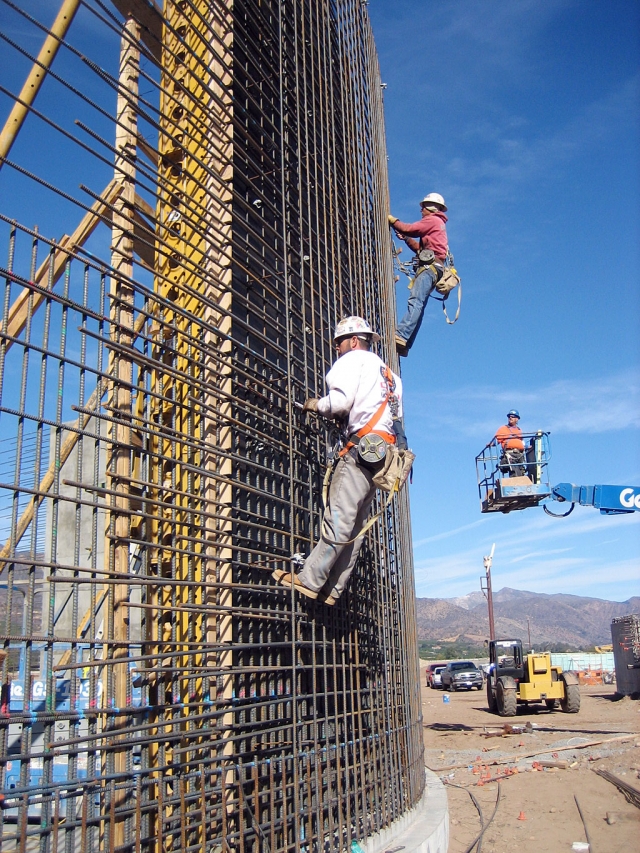 Construction workers are shown installing concrete reinforcement for 1 MG Recycled Water Storage Tank at Fillmore’s new Water Reclamation Facility. Enlarge Photo By Anonymous — Wednesday, March 18th, 2009
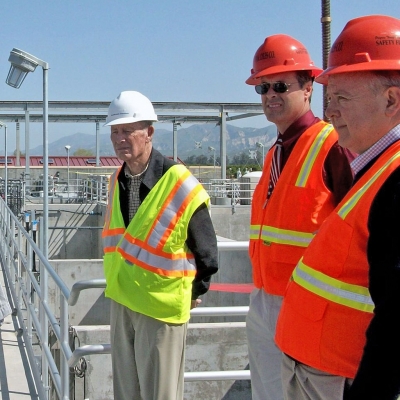 Shown is (l to r) John Jenks (Kennedy/Jenks Consultants), Bert Rapp (Public Works Director), and Dave Burkhart (Engineer) from City of Fillmore touring Fillmore’s new Water Reclamation Facility on Thursday, March 12th. Enlarge Photo story courtesy Rena Chin and Bert Rapp John Jenks, Senior Principal Engineer at Kennedy/Jenks Consultants, took a tour today of the new Fillmore Water Recycling Plant, currently under construction on city-owned land at River Street and E Street. Jenks’ interest in Fillmore dates back to 1953 when he and his father, Harry Jenks, designed the original trickling filter wastewater treatment plant. In 1953 trickling filter sewer treatment technology was cutting edge and Harry Jenks held a patent on the technology. The plant designed by John and Harry Jenks has operated continuously and provided wastewater treatment for the community for over half a century. However, it had come to the end of its useful life and ability to meet increasingly stringent water treatment standards. Fillmore’s Public Works Director Bert Rapp says, “I was thrilled to have John Jenks visit on March 12th. We toured the old plant which brought back lots of memories. It was good to see the old plant still performing.” The City is using a Design/Build/Operate (DBO) project approach to complete the new plant. The DBO approach is producing about 15% savings for the City, according to Rapp. American Water Company was selected to lead the DBO team of W.M. Lyles Construction Company and Kennedy/Jenks Consultants (design engineer). “It has been fascinating watching the Kennedy Jenks engineers work with the American Water Operators and W.M Lyles contractors to find the most efficient and cost effective ways to build the treatment plant,” says Rapp. When construction is completed, American Water will maintain and operate the Water Recycling Plant over the next 20 years. During Jenk’s visit, he also walked through the new plant that his engineers have designed and is now about 80% constructed. Rapp comments, “John is sharp as a tack, remembering the design flow rates and water quality parameters for the plant. I suppose, once an engineer, always an engineer.” When it begins operation this summer, the new $26.5 million, zero-discharge plant will treat 2.4 million gallons of wastewater per day. The new plant will use a state-of-the-art membrane bioreactor treatment system that will treat and produce wastewater that is 10 times cleaner than conventional methods. This will allow the city to recycle all its wastewater and use it for irrigation within the city. Kennedy/Jenks Consultants has provided engineering and scientific solutions for municipal agencies and industries since 1919 and celebrates its 90th anniversary this year. The employee-owned firm has 25 offices serving clients nationwide and providing consulting services to the water environment, transportation, federal, and industrial sectors. |
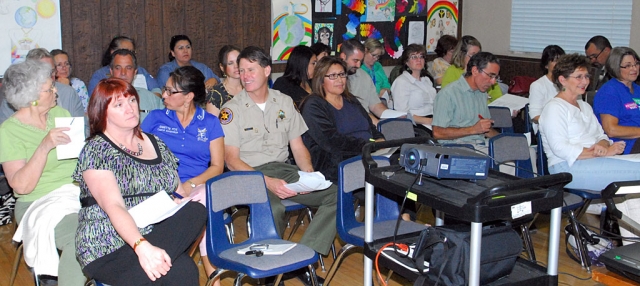 Citizens of FIllmore along with employees of Fillmore Unified School District were present at Tuesday night’s school board meeting to hear how the school is going to handle the budget cuts for 2009/2010 school year. Enlarge Photo By Mariandrea Mueller — Wednesday, March 18th, 2009
The Boardroom at the Fillmore Unified School District (FUSD) administration building was filled with people and tension on the evening of Tuesday, March 17, 2009. Assistant Superintendent Mike Bush gave a presentation on why the budget should not be balanced through eliminating the School Resource Officer, implementing furlough days, reducing transportation costs, or planning to increase attendance. The Board heard a report on the Career Technical Education Program, approved a contract for a tumbling coach and choreographer, approved new courses, and approved field trips. Most of the meeting was taken up with Bush's presentation on budget-related concerns. He presented information on the School Resource Officer (SRO), furlough days, transportation, and attendance rates. Bush mentioned reducing Instructional Assistants' hours, but did not go into detail. Having an SRO costs approximately $180,000 annually. FUSD provides $100,000, or 75% of those costs, and the rest is paid by the City and Sheriff's Department. Fillmore is the only city in the county whose SRO is subsidized by the Sheriff's Department. Police Chief Tim Hagel noted that the SRO made 229 arrests on campus last year, and 49 arrests this quarter. Last year's arrests consisted of 216 misdemeanors and 13 felonies, which were typically weapons charges. Arrests are usually made for fighting or possessing drugs or weapons. The SRO regularly issues truancy citations which increase attendance. Fillmore High School (FHS) Principal John Wilber, Fillmore Middle School (FMS) Principal Todd Schieferle, and other administrators spoke about the increased level of safety an SRO provides by knowing the relevant laws, being consistent, patrolling to prevent trouble, and responding quickly when arrests need to be made. According to Hagel, there are 150 registered gang members in Fillmore and 50 of them attend school. He said that using private security rather than an SRO would lead to fewer arrests and increased violence on campuses. CONTINUED » |
|
By Anonymous — Wednesday, March 18th, 2009
A 459 PC Burglary occurred some time between 3/16/09 at 6:30 p.m. hours, to 3/17/09 at 4:25 am hours. There were a total of six "Sea cans" (40 ft. steel storage containers) broken into at the Sewer Plant site. There are two victims, W.M. Lyles Co.(General contractor) who estimated a loss of construction tools approximately $25,000.00 and Cadri Co. Inc. (Electrician) who estimated a loss of construction tools approximately $20,000.00. |
|
By Anonymous — Wednesday, March 18th, 2009
On March 1, 2009 at approximately 9:20 pm, officers from the Santa Paula Police department responded to the 700 block of W. Main Street for a call of a gunshot victim. Upon the arrival of the officers, Jesus Ramos was found to the rear yard of his residence suffering from a single gunshot wound to his upper body. After Ramos was given During the course of the investigation, it was discovered that during a family gathering Ramps became involved in a physical altercation with Anthony Robledo. During the altercation; was shot one time. Based on witness statements, Robledo was initially arrested for attempted homicide and was later released pending further investigation. As the investigation continued, it was then discovered that 35 year old Leonard Olvera was primary suspect in the shooting involving Ramos. CONTINUED » |






